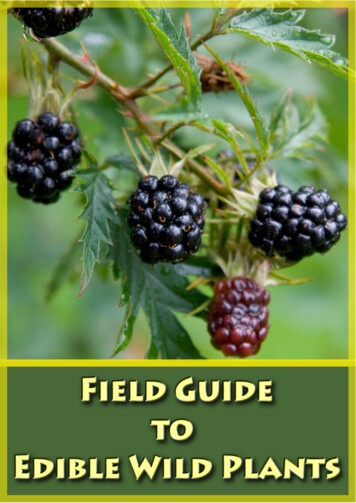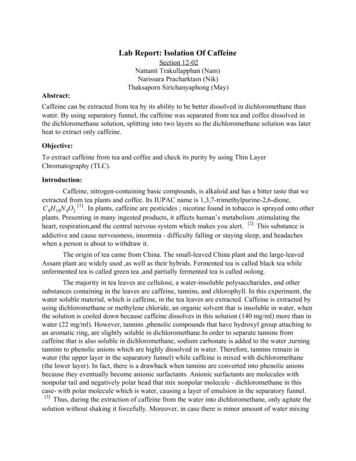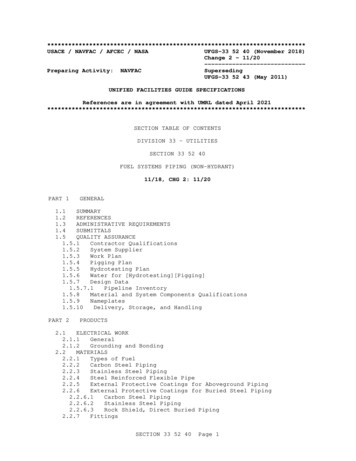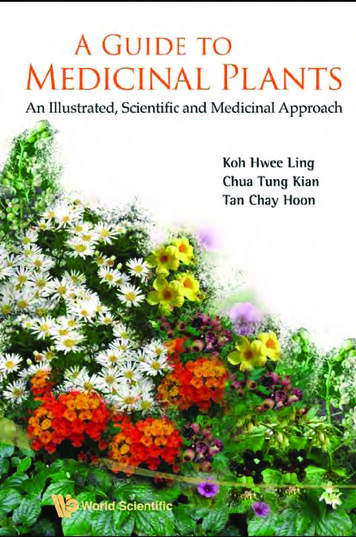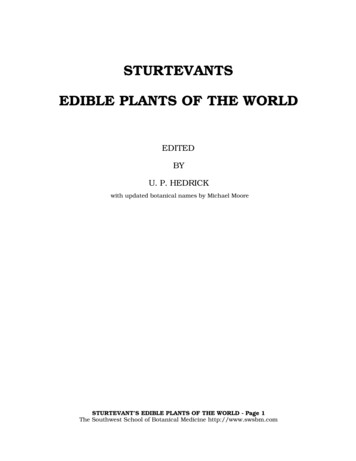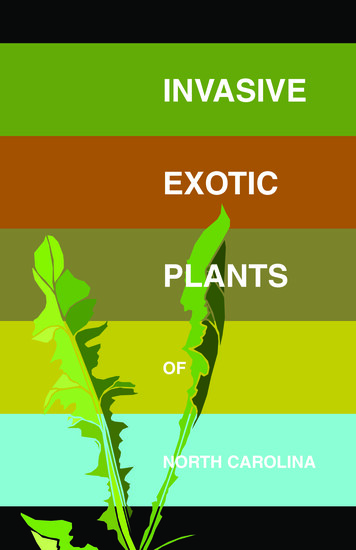
Transcription
INVASIVEEXOTICPLANTSOFNORTH CAROLINA
Invasive Plants of North CarolinaCherri SmithN.C. Department of Transportation 2008
ContentsIntroduction.5CHAPTER 1: Threat to Habitat and Natural AreasTrees.12Shrubs.20Herbaceous Plants.28Vines.44Aquatic Plants.52CHAPTER 2: Moderate Threat to Habitat and Natural AreasTrees.60Shrubs.64Herbaceous Plants.78Vines.84Aquatic Plants.96CHAPTER 3: Watch ListTrees.104Shrubs.110Herbaceous Plants.118Vines.136Aquatic Plants.144Appendix A: List of Native Plants and Seeds.152Appendix B: Southeast Exotic Pest Plant Council .Early Detection and Distribution Mapping System.161Appendix C: Resources for Additional Information.164Appendix D: Federal Noxious Weed List.165List of References.170index.183
IntroductionLand managers in North Carolina face considerable challenges in theirefforts to control invasive exotic plants. Although most of our exotic plantshave little or no impact on natural areas, and in many cases are highlybeneficial (e.g. agricultural crops and most ornamentals), a small percentageare threats to native plants, biological diversity and habitat value.Land management in North Carolina is diverse — from roadsides toagricultural fields to unique natural heritage sites. The primary purpose ofthis guide is to provide technical information regarding the identificationof those plants that pose the most threat to wildlife habitat and naturalareas, habitats most susceptible to invasion, and methods to control oreradicate these plants.Information about this guideThe 74 species of exotic plants highlighted in this guide are included as aresult of input from a variety of sources and agencies. In addition to thelist of invasive plants compiled by the North Carolina Native Plant Societythat was used as a starting point for the content of this guide, a numberof state and federal agencies made suggestions based on their experiencemanaging natural areas.The plants are divided into 3 main categories depending on their reportedimpact to natural areas: 1) threat to habitat and natural areas, 2) moderatethreat to habitat and natural areas, and 3) watch list. The 17 species inthe threat section are known to be invasive and to degrade habitat. Those17 species listed as a moderate threat do not, at present, appear to be assignificant of a problem in natural areas. The watch list includes 40 speciesthat have caused problems in neighboring states, are currently found inlocalized areas but should be watched for expansion in range, and/or arestate-listed noxious weeds. Information pertaining to the identification ofthe species on the watch list and their current status in neighboring statesor in North Carolina is presented in this section.Scientific nomenclature throughout this manual generally followsthat of Alan S. Weakly’s Flora of Carolinas, Virginia, and Georgia, andSurrounding Areas (2007). Images from numerous photographers were
generously donated for this project, and credits appear with the individualphotographs.Persistence and often a long-term commitment are necessary tosuccessfully control the multitude of invasive exotic plants found in ourstate. The rewards for this work are great and can mean the differencebetween a monotypic landscape and a landscape full of the biologicaldiversity and natural heritage that distinguish North Carolina from otherplaces on earth.AppendicesPrevention of the further spread of plant species posing a threat to naturalareas must be a common priority among all land managers in NorthCarolina. Appendix A contains a list of common native plants arranged bytype and native seeds for soil stabilization as recommended alternatives tochoosing invasive exotic species.As the list of species to watch continues to grow, we must also improve ourefforts at early detection and response. Appendix B contains informationabout a project that the Southeast Exotic Pest Plant Council (SE-EPPC)has initiated called the Early Detection and Distribution Mapping System(EDDMapS). This project will go a long way to help land managersprioritize management strategies, identify leading edges of activelyspreading infestations, and rapidly respond to new invasions. Since thesuccess of this online mapping project depends on the participation ofall land managers in this state, information regarding how to report aninfestation is included in this appendix.A list of additional resources for exotic and native plants is provided inAppendix C. This list highlights some of the most widely used resourceson these topics and is not intended to be comprehensive. Appendix Dcontains the Federal Noxious Weed List as of June 30, 2006.Noxious weedsNoxious weeds are those plants in any stage of development whosepresence is detrimental to crops or other desirable plants, livestock, and
land or is injurious to the public health. In North Carolina, every weedthat is listed on the Federal Noxious Weed List (Appendix D) is also astate noxious weed.In addition to the federal noxious weeds, the N.C. Department ofAgriculture and Consumer Services (NCDA&CS) lists weeds if they havebeen determined to cause harm and are not native to North Carolina. It isthe role of the NCDA&CS Plant Industry Division to prevent the entryand movement of noxious weeds into North Carolina or out of regulated(quarantined) counties within the state to non-quarantined countieswithin the state and to assist with control and eradication when practical.The 18 state-listed noxious weeds are included in this manual and arehighlighted by .Noxious weeds (or regulated articles such as soil) cannot be brought intoNorth Carolina. For certain species of noxious weeds that are quarantinedin particular counties, the movement of these weeds into other countiesis prohibited except by permit. The sale of all noxious weeds is prohibitedwith the exception of Celastrus orbiculatus (Oriental bittersweet) whichcan only be sold in 18 quarantined counties in western North Carolina.Additional information about noxious weed regulations is available onlineat m.Information on chemical treatmentsFor most of the terrestrial species in this manual, glyphosate and triclopyrare recommended for chemical control. There are no restrictions on theuse of these 2 chemicals in natural areas so many land managers usethem almost exclusively. Important differences exist between the oil- andwater-based forms of triclopyr. Triclopyr-TEA (water-based) can be usedfor cut stump and foliar treatments but not for basal bark treatments.Triclopyr-BEE (oil-based) can be used for basal bark, cut stump, and foliartreatments but is more volatile and much more likely to drift. TriclopyrBEE should not be used near water.Chemicals other than glyphosate and triclopyr have been used to controlinvasive exotic plants with higher rates of success. These additional
chemicals and application rates are specified where this information isavailable. Consult the North Carolina Agricultural Chemicals Manualfor comprehensive information regarding pesticides. County CooperativeExtension Service agents can also provide assistance with chemicalsand application rates. Always consult with the N.C. Department ofEnvironment and Natural Resources Division of Water Resources, AquaticWeed Control Program before initiating any control method usingchemicals in aquatic areas. As with all pesticides, label directions must befollowed to ensure efficacy of treatment and to minimize adverse impacts.
AcknowledgementsThe comprehensive reviews of this field guide by a number of individualsare greatly appreciated and proved invaluable to the completion of thiswork. Many thanks go to the following individuals:Karen M. Lynch, Bruce Ellis, Steve Mitchell, Dennis Herman and Gordon Cashin,N.C. Department of Transportation Natural Environment UnitDerek Smith, Kevin Clemmer, Connie Morgan and Bob Kopetsky, N.C. Department ofTransportation Roadside Environmental UnitMarshall Ellis, N.C. Department of Environment and Natural Resources Division of Parksand RecreationRick Iverson, N.C. Department of Agriculture and Consumer ServicesJohnny Randall, Ph.D., N.C. Botanical GardenRobert J. Richardson, Ph.D., N.C. State UniversityKaren Hall, N.C. State UniversityPerry Sugg, N.C. Ecosystem Enhancement ProgramMargaret Fields, The Nature ConservancyThanks also go to Emily Jones, N.C. Department of Transportation Communications Officefor her artistic talents regarding the layout of this field guide and to Marcia Nye for hercopy-editing assistance.In addition, thanks to the following individuals who provided importantinput regarding the plant species included in this field guide:Nancy Fraley, Southeast Exotic Plant Management TeamCarol Price, Mark Johns, Kelly Hughes, Travis Wilson and Marla Chambers,N.C. Wildlife Resources CommissionLee Patrick, Invasive Plant Control, Inc.Kristine Johnson, Great Smoky Mountains National ParkMisty Buchanan, Mike Schafale, Bruce Sorrie and Richard LeBlond, N.C. NaturalHeritage ProgramGary Kauffman, United States Department of Agriculture Forest ServiceCarolyn Wells, Ph.D., U.S. Fish and Wildlife ServiceStratford Kay, Ph.D., N.C. Division of Water QualityChris Militscher, United States Environmental Protection AgencyMary Frazer, N.C. Department of Transportation Natural Environment Unit
chapter 1threattreesshrubsherbaceous plantsvinesaquatic plants
12threatAilanthus altissima (Tree-of-Heaven)Simaroubacea (Quassia Family)Initial Introduction and Expansion in RangeNative to China, Ailanthus altissima was brought to the United States in1784 by a Philadelphia gardener. Its rapid growth rate and ability to growin harsh conditions with little care made this tree a popular horticulturalplant relatively quickly in the east. It was spread to the west by Chineseminers during the California gold rush who cultivated the seeds formedicinal purposes. In North Carolina, A. altissima is most prevalent in thepiedmont and mountain regions but can also be found on the coastal plain.An individual A. altissima tree can produce several hundred thousand seedsper year, and the light winged seeds can be carried great distances from theparent plant. It grows vigorously and establishes dense, clonal thickets thatcan displace native vegetation. The ability of A. altisimma to tolerate poorsoils and atmospheric pollution make it a common colonizer in urban areas.Roadways provide the perfect migration routes for this tree.Description and Biology Small to medium sized deciduous tree up to more than 80 feet in height. Alternate, compound leaves composed of 10 to 40 leaflets arranged .along the leaf stem with a terminal leaflet. Leaflets are lanceolate .and not always directly opposite. Each leaflet has 1 to 3 teeth on .each side close to the base. When crushed, leaves produce a distinctive .unpleasant odor described as “burnt peanut butter.” Smooth gray bark that cracks with age. Young twigs are light brown and stout with fine hairs. Flowers in July and August with flowers occurring in panicles (much .branched flower clusters) at the end of branches. Greenish-yellow .flower has 5 sepals and 5 petals. Seeds encased in papery wing-like sheath called a samara. Samaras are .slightly twisted or curled. Often confused with Rhus spp. (sumac) and Juglans nigra (black walnut).
treesHabitats Susceptible to InvasionAlthough A. altissima is most common in urban areas, it poses anenvironmental threat because of its invasiveness in cultivated fields andnatural areas. Seedlings can establish a deep taproot within 3 months fromgermination allowing the plant to grow quickly and out-compete nativespecies for sunlight and space. It thrives in full sun but also exhibits shadetolerance. In addition, this plant produces an allelopathic chemical thatprevents other plants from growing in its vicinity. Roadsides throughoutthe piedmont and mountains are infested with A. altissima providing theideal habitat and conduit for spread of this plant.Prevention and ControlLarge female fruit bearing trees should be targeted for control to helpreduce the spread of this plant by seeds. Hand-pulling young seedlings(no more than 0.5 inch in diameter) is possible when the soil is moist.Care must be taken to remove the entire plant since root fragments .can re-grow.Ailanthus altissima photography by James H. Miller, USDA Forest Service, Bugwood.org (left) andLeslie J. Mehrhoff, University of Connecticut, Bugwood.org (right).13
14threatFor thickets of A. altissima, apply a foliar solution of 4 percent glyphosateplus a 0.5 percent non-ionic surfactant. The most successful chemicalcontrol can be achieved with a foliar solution of 1.0 oz metsulfuron/100gallons water plus a 0.5 percent non-ionic surfactant. This solution willtreat an area approximately the size of an acre.For larger trees, cut them within 6 inches of the ground and immediatelyspray the freshly cut stump surface and sides with a solution of 50 percenttriclopyr. It is best to apply the herbicide between summer and early fallwhile the plant is translocating nutrients to the roots.The hack-and-squirt method is effective for controlling A. altissimaparticularly when conducted in the summer. Use an ax to makedownward-angled cuts into sapwood around the tree trunk as close to .the ground as possible. Immediately squirt a 50 percent solution oftriclopyr into the cuts so that the bottom of the cut is covered, but .liquid does not run out. Space the cuts so that about 1 to 2 inches .of uncut living tissue remains between the cuts since a continuous linemay cause an emergency response in the plant resulting in basal sproutsand root suckers.Basal bark application of herbicide is one of the easiest methods ofcontrol for trees up to 6 inches in diameter. This method should be usedjudiciously since it takes a lot of chemical and can result in overspray. Ithas been used successfully in situations where no other technique is easysuch as cliff faces or other exposed sites. Apply a solution of 25 percenttriclopyr and 75 percent mineral oil to the basal parts of the tree to aheight of 12 to 16 inches from the ground during the late winter/earlyspring or summer. All treatments should be followed up the next year tomonitor and control basal sprouts and root suckers.
treesPaulownia tomentosa (Princess Tree)Paulowniaceae (Paulownia Family)Initial Introduction and Expansion in RangeNative to eastern Asia, Paulownia tomentosa has been widely planted forhorticultural purposes in North America from Montreal to Florida andwest to Missouri and Texas. This tree is moderately cold-hardy so it hasspread principally in the Eastern and Southern portions of the UnitedStates. In North Carolina it poses a particular problem in the foothill andmountain regions.Paulownia tomentosa is capable of flowering within 8 to 10 years and amature tree can produce millions of seeds. The seeds are small and winged,dispersing easily in the wind. This aggressive tree grows rapidly (up to 15feet per year) in all types of disturbed habitats.Description and Biology Small to medium sized deciduous tree up to 50 feet in height. Large (5 to 10 inches long on mature trees) heart-shaped leaves .arranged oppositely along the branches. Young plants and stump .sprouts have leaves up to twice the size. Thin grayish brown bark with shallow fissures. Flowers in April and May before leaf emergence. Arranged in upright .pyramidal clusters, the flowers are lavender and showy. Fruits are oval capsules initially sticky and green, later turning brown .and dry persisting on the tree through the winter. Often confused with Catalpa bignonioides (southern catalpa). The .long slender persistent beans and whorled leaves of Catalpa help .distinguish it from P. tomentosa.Habitats Susceptible to InvasionPaulownia tomentosa is an extremely fast-growing competitor with nativespecies in disturbed natural areas including forests, stream banks and steeprocky slopes. It tolerates high soil acidity, drought, and low soil fertilityenabling it to survive, grow, and reproduce on harsh, exposed sites.Roadsides provide ideal habitat and migration routes for this plant.15
16threatPrevention and ControlPaulownia tomentosa was originally introduced as an ornamental and isstill planted for that purpose. The wood of this tree is highly prized inAsia leading to the establishment of commercial plantations in the UnitedStates. Successful control of this plant will first require prevention ofpropagation and planting.Young seedlings (no more than 0.5 inch in diameter) can be pulled byhand when the soil is moist. Care must be taken to remove the entire rootsince broken fragments may re-sprout.Seedlings and young trees can be controlled with a foliar solution of 3percent glyphosate plus a 0.5 percent non-ionic surfactant to thoroughlywet all leaves. For larger trees, cut them down within 6 inches of theground and immediately spray the freshly cut stump surface and sides witha solution of 50 percent triclopyr. It is best to apply the herbicide in thesummer to early fall while the plant is translocating nutrients to the roots.Trees up to 6 inches in diameter can be controlled with a basal barkapplication of herbicide. This method should be used judiciously sinceit takes a lot of chemical and can result in overspray. It has been usedsuccessfully in situations where no other technique is easy such as clifffaces or other exposed sites. Apply a solution of 25 percent triclopyr and75 percent mineral oil to the basal parts of the tree to a height of 12 to 16inches from the ground during the late winter/early spring or summer. Alltreatments should be followed up the next year to monitor and controlbasal sprouts and root suckers.
trees17Paulownnia tomentosa photography by Leslie J. Mehrhoff, University of Connecticut, Bugwood.org .(top left), Cherri Smith, NCDOT (top right) and Steve Mitchell, NCDOT (bottom).
chapter 1threattreesshrubsherbaceous plantsvinesaquatic plants
20threatLigustrum sinense (Chinese Privet)Oleaceae (Olive Family)Initial Introduction and Expansion in RangeLigustrum sinense was introduced to the United States from China as agarden plant in 1952. It has been widely planted for hedges and has sinceescaped cultivation spreading throughout the Southeast and Midwest.Ligustrum sinense is now found in all 3 physiographic regions of NorthCarolina. This shrub prefers moist soil conditions but is also found onupland sites usually at elevations less than 3,000 feet.A single mature L. sinense shrub can produce hundreds of fruits that are afavorite food for a number of bird species. Although L. sinense can spreadby suckers, birds are by far the primary dispersal mechanism of this plant.Description and Biology Large evergreen shrub up to 15 feet tall. Small (usually 1 to 1.5 inches long) elliptic, smooth-.edged leaves arranged oppositely along the twigs. Leaves are thick .with a glossy upper surface and a pale green lower surface. Midrib of .each leaf is hairy. Smooth light tan to gray bark. Small white flowers arranged in branching clusters at the ends of .branches bloom in June and July. Small black fruits ripen in August and September. Resembles Ligustrum japonicum (Japanese privet) which has larger, .more glossy leaves and is further described in this document.Habitats Susceptible to InvasionLigustrum sinense is usually found in bottomlands, low woods, stream sidesand disturbed areas. Roadsides and fence-rows are avenues contributingto the expansion in range of this plant. Ligustrum sinense is an extremelyaggressive shrub forming dense, impenetrable thickets that can shadeout the herbaceous layer altering the natural species composition andcommunity structure of natural areas.
shrubsPrevention and ControlIf an infestation of L. sinense is caught early, the possibility of successfulcontrol and eradication is good. Well-established thickets of L. sinense canbe controlled but complete eradication is difficult.Young seedlings (no more than 0.5 inch in diameter) of L. sinense can beeffectively controlled by hand-pulling. Stems up to 2 inches in diameter canbe manually removed by tools designed for this purpose, such as a WeedWrench. Larger plants can be killed by spraying the foliage with a 2 percentsolution of glyphosate or triclopyr and a 0.5 percent nonionic surfactant.Ideally, the plants should be sprayed in the late fall or early spring whentemperatures are above 65 degrees Fahrenheit and many native species aredormant. As long as the ground is not frozen, this shrub can also be killedby cutting it down within 6 inches of the ground and immediately sprayingthe freshly cut stump with a 50 percent solution of triclopyr. All treatmentsshould be followed up the next year to monitor and control basal sproutsand root suckers.Ligustrum sinense photography by Troy Evans, Bugwood.org (top) and Chuck Bargeron, Universityof Georgia, Bugwood.org (bottom).21
22threatRosa multiflora (Multiflora Rose)Rosaceae (Rose Family)Initial Introduction and Expansion in RangeNative to Japan, Korea and China, Rosa multiflora was introduced tothe United States in the 1860s as rootstock for ornamental roses. In the1930s, the Soil Conservation Service (renamed the Natural ResourceConservation Service in 1994) promoted this plant for erosion control andliving fences for containing livestock. Various conservation organizationshave also promoted its use for wildlife cover and food. In some states, R.multiflora was planted within highway medians as a crash barrier and as ameans to reduce headlight glare from oncoming vehicles. It is now foundthroughout North Carolina.Rosa multiflora reproduces by rooting at the tips of its arching branchesand by seed. In a good year, an average size R. multiflora shrub canproduce 500,000 to 1,000,000 seeds. This plant has become a seriousthreat to natural areas not only because its seeds are widely dispersed bybirds, but because of its ability to grow in diverse light, soil and moistureconditions.Description and Biology Medium-sized, deciduous, thorny shrub up to 10 feet in height. Stems distinctly arching in form. Compound leaves composed of 5 to 11 leaflets alternately arranged .along the stem with a terminal leaflet. Each leaflet broadly oval with a .serrate (toothed) margin. A feathery stipule (green, leaf-like structure) .is found at the base of each leaf. Clusters of fragrant, white to pinkish-white, 5-petaled flowers .bloom in May or June. Small red fruits called “rose hips” develop during the summer and can .persist on the plant through winter. Distinguished from other native species of roses by arching stems and .feathery stipule.Habitats Susceptible to InvasionRosa multiflora forms dense impenetrable thickets that can choke outnative understory species. Roadsides, pastures, wetlands (i.e. mountain
shrubs23bogs) and other non-forested areas are particularly susceptible to invasion.Disturbed right of ways provide the ideal conditions for the spread of this plant.Prevention and ControlCutting or mowing R. multiflora at least once during the growing seasonwill control but not eradicate this plant. Small plants can be dug out byhand. Large plants can be pulled from the ground by tractors or trucksusing strong ropes or chains.Rosa multiflora can be effectively controlled from spring through fall witha foliar solution of 2 percent glyphosate or triclopyr plus a 0.5 percentnon-ionic surfactant that thoroughly wets the leaves. The most successfulchemical control can be achieved with a foliar solution of 1 ouncemetsulfuron/100 gallons water plus a 0.5 percent non-ionic surfactant.This solution will treat an area approximately the size of an acre.If foliar spraying is not an option because of proximity to sensitive areas,R. multiflora can be effectively controlled with the cut stump method anytime of year as long as the ground is not frozen. Once the plant is cut tothe ground, immediately apply a 25 percent solution of triclopyr to thestumps taking care to cover the entire surface. All treatments should befollowed up the next year to monitor and control sprouts.Rosa multiflora photography by Mike Kunz, NC Botanical Garden (left) and James H. Miller, USDAForest Service, Bugwood.org (right).
24threatVitex rotundifolia (Beach Vitex)Lamiaceae (Mint Family)Initial Introduction and Expansion in RangeVitex rotundifolia has a widespread distribution and is found on beachesfrom China, Taiwan, Japan south to Malaysia, India, Sri Lanka, Australiaand Hawaii. It was introduced to the South Carolina coast in the 1980sto control erosion. It is a quickly growing landscape plant tolerant of saltand drought. By the mid-1990s, V. rotundifolia had escaped cultivationand was rapidly spreading along the beaches in South Carolina. It is nowfound in North Carolina. Vitex rotundifolia is currently in considerationfor being listed in North Carolina as a state noxious weed.Seed production of this plant can be as high as 10,000-20,000 seedsper square meter. In addition to reproduction from seeds, broken shootfragments can also establish new populations of this plant. As stormswash the seeds and shoots to new beaches, V. rotundifolia has the ability tobecome established great distances from existing populations.Description and Biology Deciduous, sprawling shrub reaching 1 to 2 feet in height and up .to 12 feet in diameter. Runners from this shrub have been documented.up to 60 feet in length. Smooth, round, dark gray-green leaves. Underside of leaves is lighter .green to whitish gray. When crushed, the leaves have a spicy fragrance. In the summer, bluish-purple flowers bloom in clusters at the ends of .branches. Spherical, black, dry fruits between 0.25 and 0.5 inch in diameter .persist on the plant through the winter.Habitats Susceptible to InvasionVitex rotundifolia thrives in full sun, sandy soils and moderatetemperatures. This plant forms a thick monoculture on dunes creatingdeep shade that inhibits the establishment of native species. Uniolapaniculata (sea oats) and the federally threatened Amaranthus pumilus(seabeach amaranth) cannot compete with the aggressive growth of V.rotundifolia. The thick vegetative cover formed by V. rotundifolia may alsocontribute to the decline in nesting of sea turtles.
shrubsPrevention and ControlConsult with the appropriate Division of Coastal Management field officebefore conducting any activity that involves disturbance to dunes. Nativedune species should be re-established in areas targeted for control of V.rotundifolia.Vitex rotundifolia seedlings should be pulled up as soon as they can beaccurately identified. It can be effectively controlled from spring through fallwith a foliar solution of 5 percent glyphosate plus a 0.5 percent non-ionicsurfactant that thoroughly wets the leaves. Established V. rotundifolia has beensuccessfully controlled by cutting the plant as close to the ground as possibleand applying a 10 percent solution of glyphosate to the cut stems. The cutplant material should be taken to a compost facility for proper disposal orpiled on a concrete surface until the leaves fall off and then composted. Thecut stumps should be monitored monthly for re-sprouting. Sprouts should becut to expose a fresh surface and be treated with herbicide solution.Vitex rotundifolia photography by Forest & Kim Starr, U.S. Geological Survey, Bugwood.org.25
26threat
chapter 1threattreesshrubsherbaceous plantsvinesaquatic plants
28threatAlliaria petiolata (Garlic Mustard)Brassicaceae (Mustard Family)Initial Introduction and Expansion in RangeDuring the 1800s, Alliaria petiolata was brought to the United States fromEurope as a medicinal herb and for cooking purposes. It is now foundthroughout the Northeast, the Midwest, Georgia and Oregon.Alliaria petiolata spreads exclusively by seed. Each plant can producehundreds of seeds that are ballistically dispersed up to 10 feet when thefruits burst open. Since the seeds do not float well and are probably notcarried far by wind, wildlife and human activities are probably respo
Nancy Fraley, Southeast Exotic Plant Management Team Carol Price, Mark Johns, Kelly Hughes, Travis Wilson and Marla Chambers, N.C. Wildlife Resources Commission . Ailanthus altissima (Tree-of-Heaven) Simaroubacea.(Quassia.Family) Init

